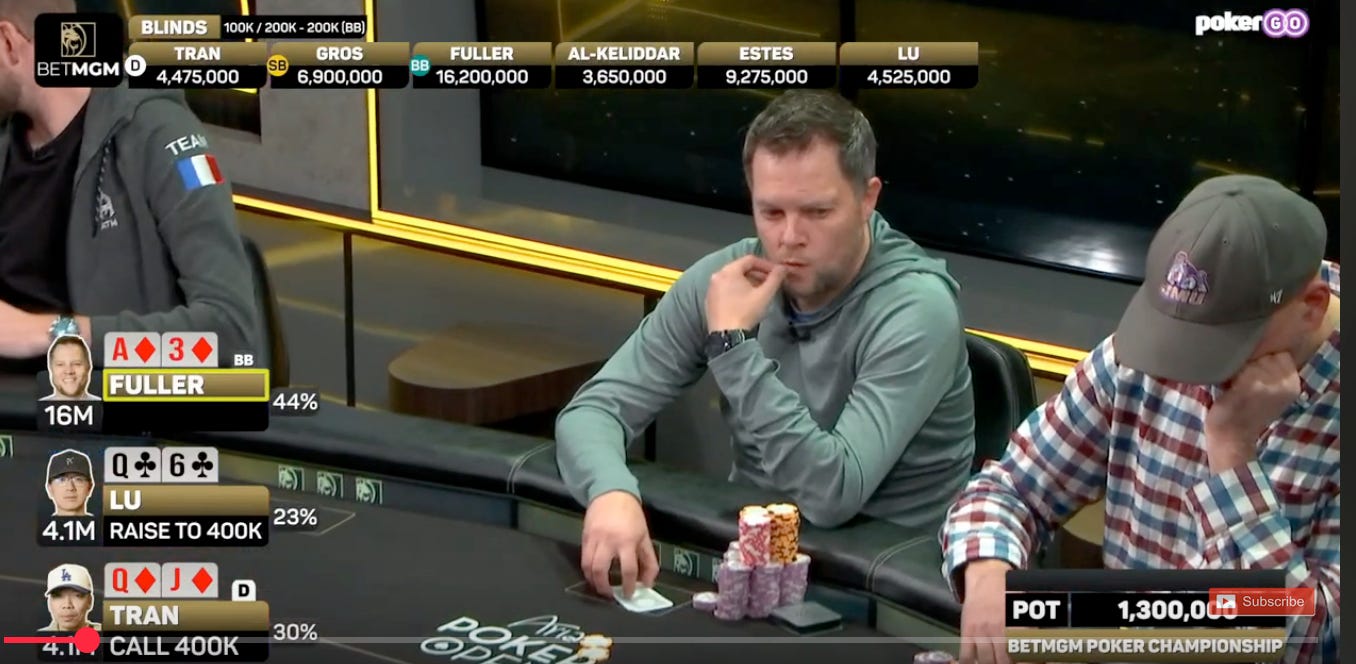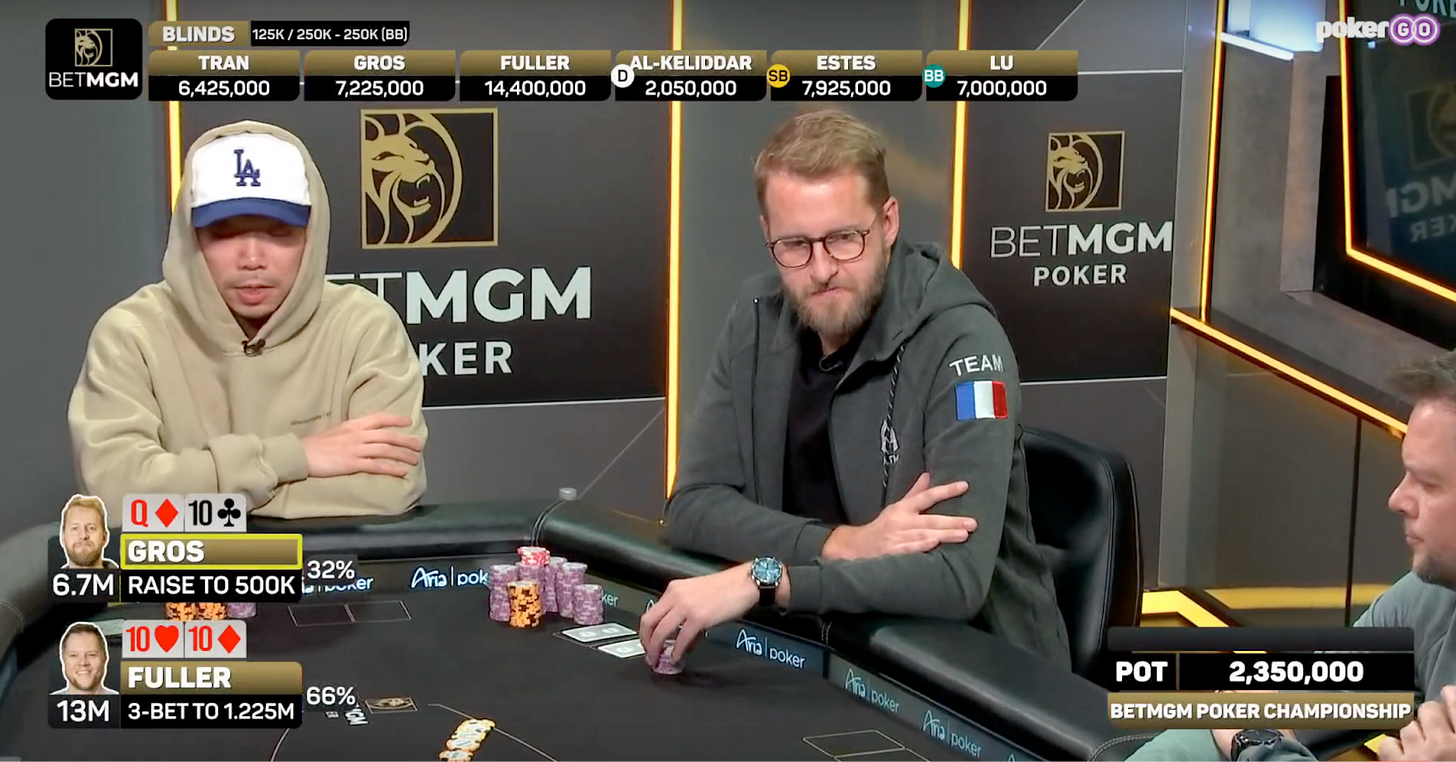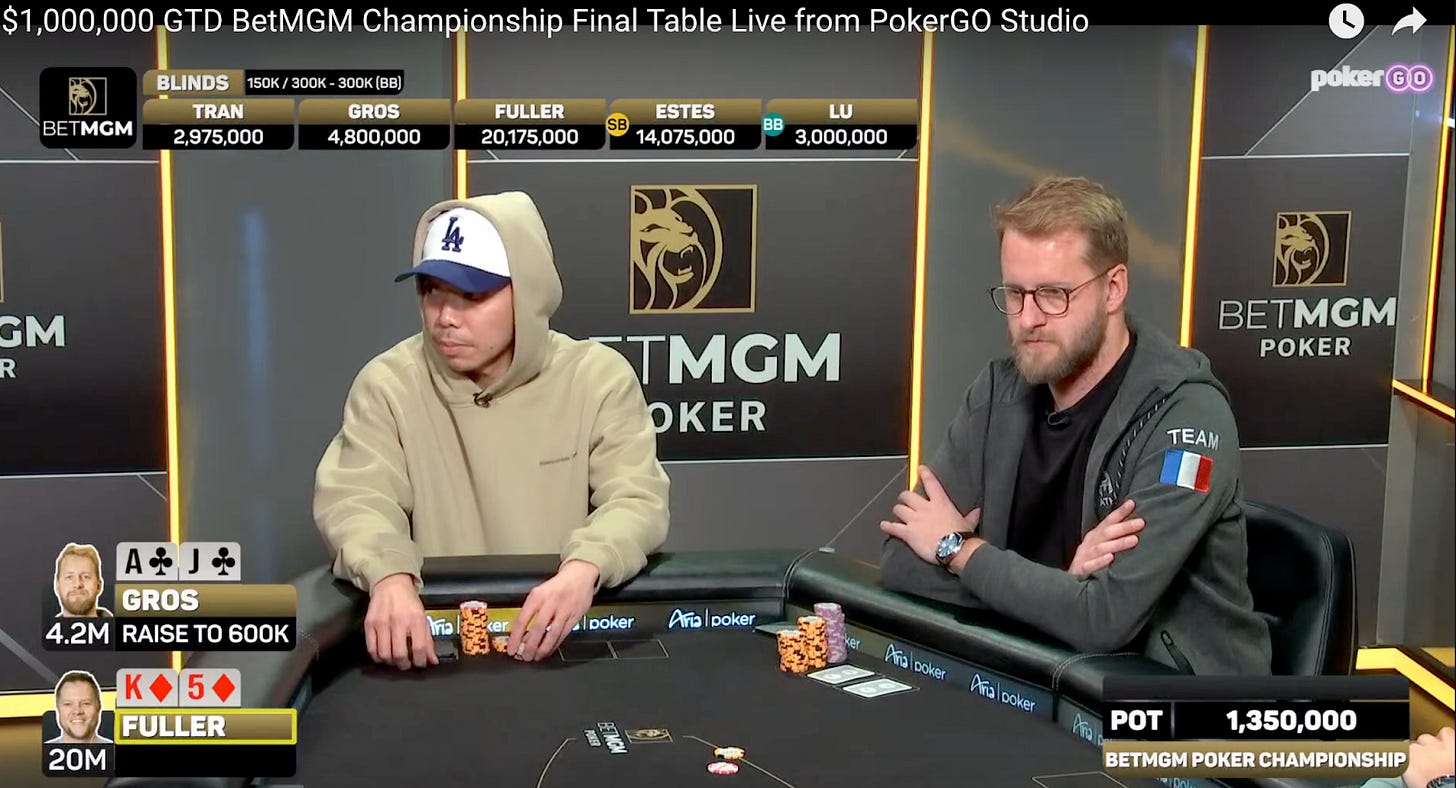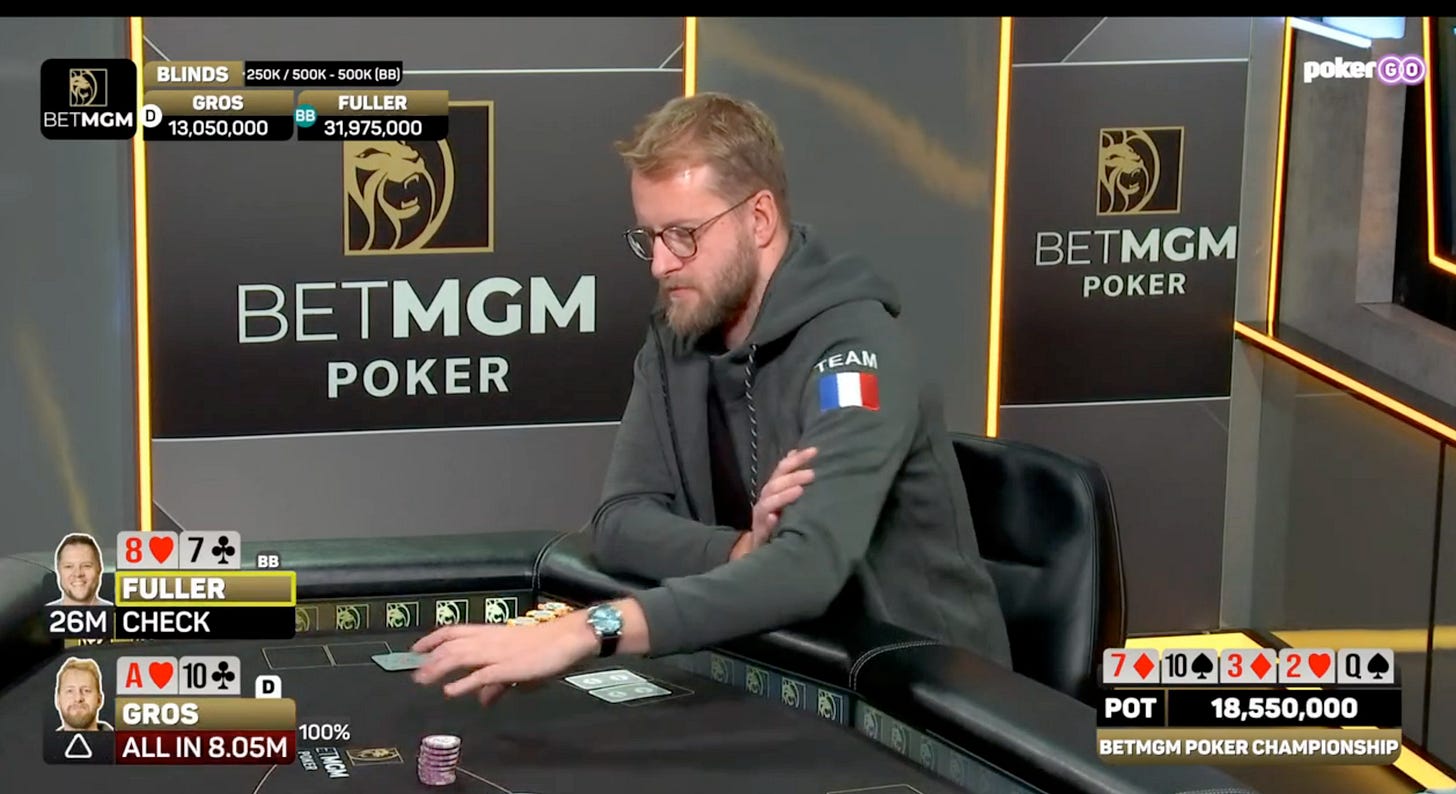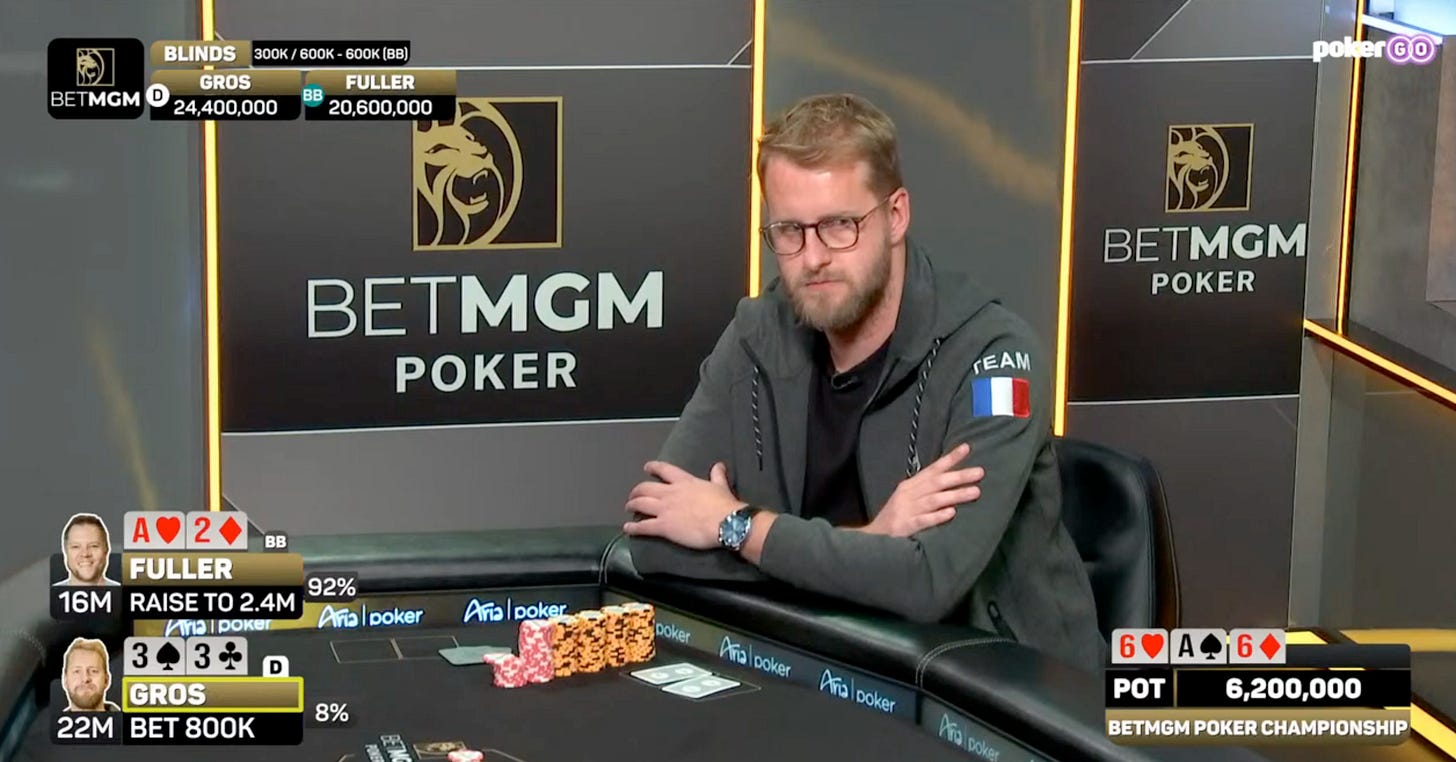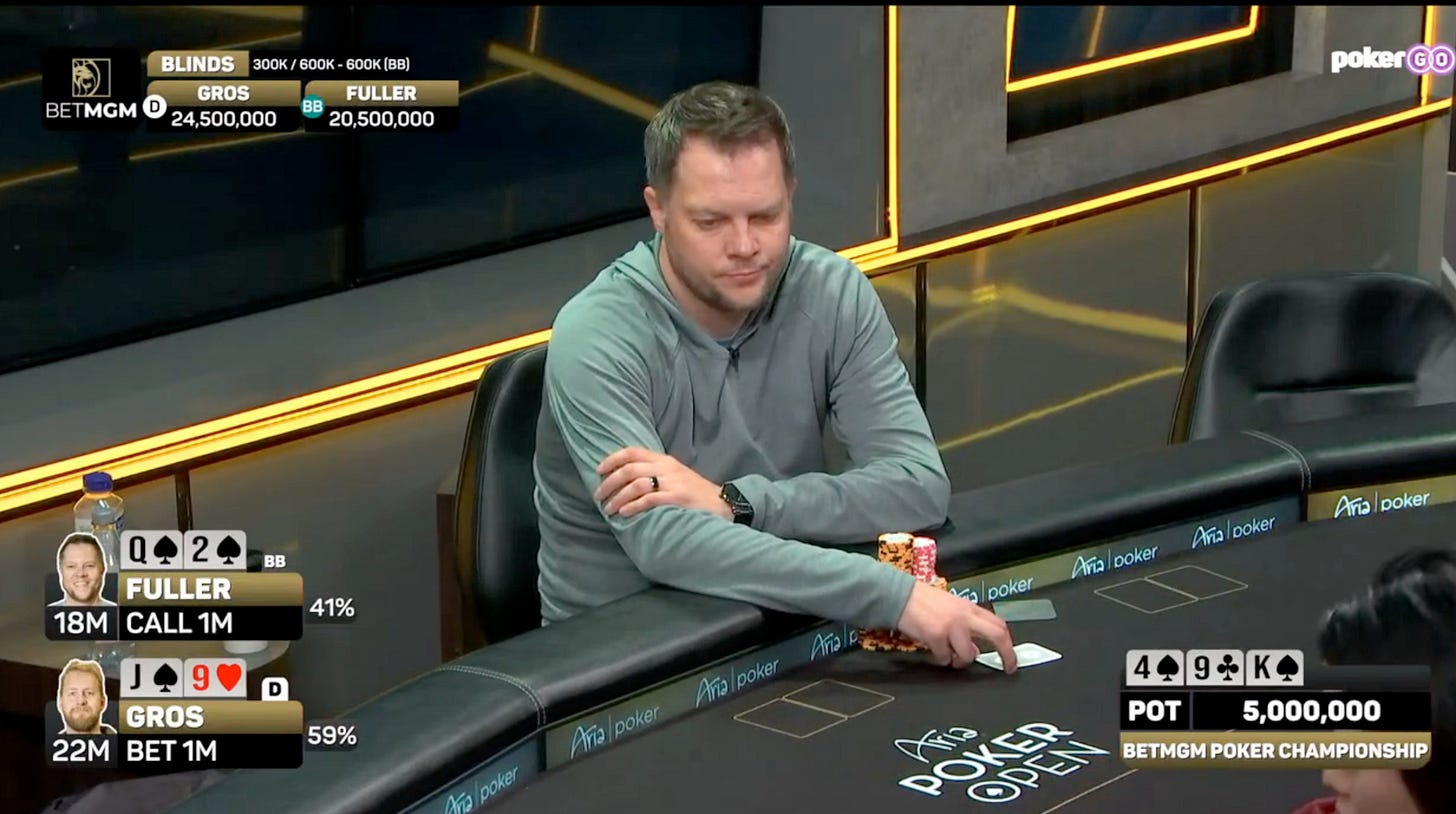Having watched so many greats walk into the PokerGo Studio, striding in there was a thrill for me. Especially since I held the chip lead with seven players left and a chance at a career-best score. After half an hour of smalltalk and filming prep, we got started. I was relieved to play in a quiet, pasteurized room after two days on the loud casino floor.
You can watch the final table here.
You won’t be impressed. I held the best cards at the final table and busted five of my six opponents. The cards largely played themselves and I was the beneficiary. I didn’t face too many difficult decisions and mostly appeared to cruise through it. But a closer look reveals several subtle mistakes. Here I’ve included all the hands I might have botched.
Early at the final table, I should move all-in here. Players like Tran don’t trap enough in this situation. I have the perfect hand to jam, a blocker with a chance if called. My jams should be balanced between big hands and stuff like this. If I know Lu is opening overly wide like this, I can squeeze anything decent. I called and lost the hand postflop.
Some have suggested I move all-in here. I prefer a limp or a small raise. I advocate a lower variance strategy as the chip leader. Al-Keliddar is a good player who can call off reasonably as the shortest stack. IMO 17 BBs is too much for 86s. I also wouldn’t expect him to raise trash here as often as a solver would at this stack depth if I limp. I think I should limp some hands and this should be one of them. I limped, he shoved pocket fours and I folded. We probably would have played a big race if I jammed.
I could call this 3-bet. I’m getting a nice price with a cracker, playing deep enough for suited connectors to pay off. Folding out of position as I did is fine too.
Estes raised the hijack here and I defended. I could 3-bet this hand, as it would get many dominating hands to fold.
Standard flop action: Check, small bet, call.
The turn went check-check, which reduces Estes’s range to weaker hands that likely have showdown value. I would expect him to bet any two pair or better on the turn, plus likely AK and AT. So I think my hand is probably best, with a chance he has a better ace.
I bet a little less than 1/4 on the river, which felt shameful when Estes snap-called a hand that led mine till the end. But I don’t regret the bet. As noted above, I expected Estes to have one pair most of the time, weighted towards queens and jacks. It’s hard for me to have a bluff on this line, so I wouldn’t expect him to pay off many large value bets. I went 1/4 because I believed that was theoretically correct in this spot with many hands. Betting small allows him to call with weak hands like KJ and QT, or to turn his hand into a bluff and raise (which I would snap-call). I thought Estes was the type of player who might be inclined to bluff-raise a block bet. With an ace, Estes snapcalled the small bet.
I raised this hand UTG/LJ and Gros defended the BB. He check-called a small flop bet and we both checked the turn. On the river he bet 60% and I had to decide if he had enough busted straight draws for me to call. Ultimately I didn’t rule Gros out from value betting a pair of nines here, which gave him more combos of pairs than busted straight draws (which he might not play this way). It’s bad for me to have a queen as it blocks QJ and QT. I folded after using a time bank.
A potential preflop 3-bet. Lu has a great stack size to attack. I have a decent hand that probably isn’t quite good enough to call, so it makes sense to 3-bet. I had so many good starting hands from two tables on down that it appeared I was playing more aggressively than I actually was. Because it appeared I was already playing aggressively, I passed on some spots like this. It’s an especially interesting dynamic at a televised final table where your opponents know what you had earlier at the final table, but won’t find out about the latest level or two until the next break. I never really caught up to just how aggressively Estes was playing preflop. Gros did, and capitalized with some badass 4-bets against him with KQs.
This appears to be a standard 3-bet with a good hand. As the chip leader, I am supposed to 3-bet Gros and stacks of his ilk relentlessly until Al-Keliddar busts. I figured I should include all my good hands in that 3-betting range. But if Gros moves all-in for 31 BBs, I would face an ugly decision with pocket tens. 3-bet folding such a good hand would be undesirable, so I should have considered flatting here.
In retrospect this should have been a 3-bet. This is a moment in the tournament where Estes is heavily disincentivized to battle me. He wants shorter stacks, especially 8BB-and-soon-to-be-shorter Al-Keliddar to bust before dancing with the big stack. At this time, I didn’t yet realize how aggressively Estes was playing. If I knew he was raising crap like this on my BB, I should 3-bet him without looking at my cards. A2o is a great hand to bluff here. I ended up calling and check-folding the flop to his airball.
Obvious 3-bet. Gros is under tremendous ICM pressure with Lu and Tran sitting on 10 BB stacks. I have a stereotypical 3-betting hand, not to mention the button.
But I misclick the amount, going to 2.2m instead of 1.2m, and then Gros jams after using a time bank. I find myself priced in to call Gros’s shove. I wrote about this embarrassing hand and its aftermath for an upcoming feature in CardPlayer Magazine, so I’ll move on for now.
KJo is the borderline hand to raise/call 12.5 BBs in this spot. Some good players I know thought I should have folded and others thought it was an auto-call. If I call and lose I am tied with Estes for the chip lead with Gros and Lu close behind. If I call and win I am in awesome position with four left with double anyone else. Lu shoved this hand so quickly it looked like some sort of obvious jam that didn’t require much thought, which decreased the likelihood of KK, AA and KQ in my mind. Lu had just doubled up Tran. These two micro factors inclined me to cross the border and call.
Another misplay of A2o against Estes. I still didn’t comprehend how aggressively he was playing. With my big chiplead, I should just open-raise this A2o to about 1m instead of limping. When Estes bludgeons my limp, a limp/reraise to around 2.7m becomes interesting. It would fold out his crap and put tremendous pressure on his decent hands. I block him from some premiums. If I do have a limp/reraising range here, A2o would sensibly be part of it.
Here I have a hand that should often 3-bet and could consider calling. But Gros is now the chip leader, with balls of steel. I know he has a wide range on the button, but I’m not sure how often I’m supposed to 3-bet him in this chip configuration. This is the kind of spot I’ve been studying watching better players navigate final tables on PokerGo.
I elected to open-limp the button here. I thought Estes would jam a lot of stuff I didn’t have blocked and Tran would rarely bludgeon my limp. I am probably unbalanced in this spot, not trapping big hands enough.
This flop gave me enough equity I was getting ready to bet, but Tran beat me to the punch. I thought he would fold a 3 or 2 without much thought. If he had an 8, I had two overcards + backdoor flush and straight draws. There were a lot of cards I could continue semibluffing on the turn. And he was a cautious player with ICM pressure on him. I wasn’t representing much other than the preflop traps, though I could have an 8.
I wrote about this hand for CardPlayer as well, so I’ll be brief here.
I found myself facing three awful options here and chose the one that felt the least awful and folded. I felt smart when I saw what he had but this laydown was as cowardly as it was brilliant.
This was a great time to pressure Estes as he had to deal with intense ICM with Tran sitting on 8 BBs.
Standard heads-up preflop and flop action here.
I don’t think I should fold yet.
On the river I have a pretty good bluff-catcher. There are no straights or flushes possible, so his value is sets, two pairs, queens he was bluffing with before the river, and good tens. The 8 in my hand blocks him from having some missed straight draws (J8, 98, 86) but I fully unblock diamonds. Gros had plenty of heart and bluffed appropriately, but I hadn’t seen him bluff-shove a river. On the brodcast they speculate I called because of a physical read, but that had nothing to do with it. I believe a solver would play the hand as I did. The river call is marginal vs a human.
Better to call with this than 3-bet it in an ICM-free environment.
I make an unconventional checkraise here for a few reasons. If I call, I probably won’t get any more action from worse hands because it looks like I have an ace or six. Gros had seen me checkraise at least two paired flops, so I wanted to propigate the idea I was often doing it (in this case with something like 74dd or 98hh). Also, I might not have a ton of aces as many would 3-bet preflop.
On the turn it’s hard to get a worse hand to call, and I could be beat. My hand isn’t good enough to checkraise and bet twice. So I check, pretending I had something like the 98hh and am giving up. He checks back.
The river is a great card for me because it gives me a chop vs. the better aces he could have. Also, I thought he might have called my flop raise with king high, which would now be two pair. So I can bet with impunity. I think I bet a little too much.
Yet another preflop misplay of A2o. I can limp/call. I can limp/raise. I can 4-bet. Raise-folding was terrible.
Standard preflop and flop action.
The turn went check/check.
On the river I bet a little more than 1/4 pot and was snap-called. Unlike the A3 two pair hand vs. Estes, I regret this small river bet. While I’m not expecting Gros to be this strong, there is plenty of stuff he can call with. I should have overbet it. I had demonstrated small bets with big hands, so Gros would be less likely to bluff-raise. I’d overbet once with the goods heads-up, so he might think my next one could be a bluff.
With Gros rocking 18 BBs, I think my best play is to raise here and happily call a jam. I think raising is better than limping because he won’t jam his 18 BBs over many limps. He could bludgeon it with some bad hands, and then I could jam, which is what I was thinking when I limped. Gros could also just fold to the raise which is a fine result with A8o. I don’t know if he was considering all this as the hand played out. If so, he would expect me to have a good ace less often. Whether I raised or limped, this was going to be the last hand of the tournament.





